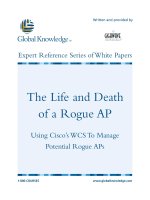Tài liệu Configuring Virtual Links pdf
Bạn đang xem bản rút gọn của tài liệu. Xem và tải ngay bản đầy đủ của tài liệu tại đây (27.04 KB, 3 trang )
1 - 3 Semester 5: Advanced Routing v2.0 - Lab 5.8.4 Copyright 2001, Cisco Systems, Inc.
5.8.4: Configuring Virtual Links
TRANSIT
AREA 51
AREA 3
AREA 0
Lo0 192.168.3.1 /24
S0/1 192.168.240.1 /30S0/0 192.168.224.2 /24
Lo0 192.168.1.3 /24
Lo1 192.168.0.3 /24
Lo0 192.168.252.1 /24
S0/0 192.168.240.2 /30
Singapore
SanJose1 Auckland
S0/0 192.168.224.1 /24
Fa0/0 192.168.248.1 /24
Objective
In this lab, you configure an OSPF virtual link so that a disconnected area can reach the
backbone, as required by OSPF.
Scenario
At midnight, your pager goes off as you are sleeping in your San Jose home. You are
informed that connectivity to Auckland and Singapore has been intermittent for several
hours. You log on to the corporate network from home, run some diagnostics, and
determine that you can’t get to Auckland. Also, you notice that the Shortest Path First
algorithm is being recalculated often on your core routers. The instability seems to be
associated with the Asian region of your network. Singapore local time is approximately
4:30 p.m. You call the technical support lead in Singapore to ask if they are experiencing
any network connectivity issues. He is disappointed that you noticed already, but he
proudly says that he has added OSPF Area 3 in Auckland so that external routes do not
need be redistributed. You agree that it would be best to include Auckland in the OSPF
autonomous system, but you disagree that another area should be created. A
teleconference is set for tomorrow, and you go about restoring connectivity and stability.
A proper OSPF design has all areas adjacent to Area 0, but Area 3 is disconnected from
the backbone. You will configure a virtual link through Area 51, connecting Area 3 to the
backbone, Area 0.
Step 1
Build and configure the network according to the diagram. Also configure multiarea OSPF
according to the diagram (do not configure the virtual link yet). Configure each router with
the loopback address indicated in the diagram.
2 - 3 Semester 5: Advanced Routing v2.0 - Lab 5.8.4 Copyright 2001, Cisco Systems, Inc.
Use ping to test connectivity between all directly connected interfaces. Each router
should be able to ping its serial link partner.
Step 2
After you configure the network according to the diagram, check Auckland’s routing table:
Auckland#show ip route
Gateway of last resort is not set
192.168.240.0/30 is subnetted, 1 subnets
C 192.168.240.0 is directly connected, Serial0/0
C 192.168.248.0/24 is directly connected, FastEthernet0/0
C 192.168.252.0/24 is directly connected, Loopback0
1. The routing table should be devoid of OSPF routes. Why?
Interarea traffic must transit the backbone area. Even though Area 51 and Area 3 are
adjacent, they do not share OSPF routing updates.
Verify that Auckland has established a neighbor relationship with Singapore by using the
show ip ospf neighbor command:
Auckland#show ip ospf neighbor
Neighbor ID
Pri
State
Dead Time
Address
Interface
192.168.240.1
1
FULL/
00:00:33
192.168.240.1
Serial0/0
2. What state exists between Singapore and Auckland?
Singapore and Auckland should have successfully established adjacencies, shown as the
“full” neighbor state.
Step 3
Because Area 3 is not connected to the backbone, OSPF routing is broken in this
network. You must configure a virtual link, or drastically redesign the network, in order to
make routing work. To quickly restore connectivity, you will configure a virtual link
between Singapore (Area 3’s ABR) and SanJose3 (Area 0’s ABR). Thus, the transit area
between Area 3 and Area 0 will be Area 51. Enter the following commands on Singapore:
Singapore(config)#router ospf 1
Singapore(config-router)#area 51 virtual-link 192.168.1.3
Note: You must specify SanJose3 by its router ID.
In order for the virtual link to function, you must configure both ends of the link. On
SanJose3, issue the following commands:
SanJose3(config)#router ospf 1
SanJose3(config-router)#area 51 virtual-link 192.168.240.1
3 - 3 Semester 5: Advanced Routing v2.0 - Lab 5.8.4 Copyright 2001, Cisco Systems, Inc.
You can verify the creation of the virtual link by checking Auckland’s routing table:
Auckland#show ip route
Gateway of last resort is not set
O IA 192.168.224.0/24 [110/845] via 192.168.240.1, 00:01:25,
Serial0/0
192.168.240.0/30 is subnetted, 1 subnets
C 192.168.240.0 is directly connected, Serial0/0
O IA 192.168.232.0/24 [110/65] via 192.168.240.1, 00:01:25,
Serial0/0
C 192.168.248.0/24 is directly connected, FastEthernet0/0
192.168.0.0/32 is subnetted, 1 subnets
O IA 192.168.0.3 [110/846] via 192.168.240.1, 00:00:35,
Serial0/0
192.168.1.0/32 is subnetted, 1 subnets
O IA 192.168.1.3 [110/846] via 192.168.240.1, 00:00:35,
Serial0/0
C 192.168.252.0/24 is directly connected, Loopback0
If it receives OSPF routes, the virtual link is operational.
Alternatively, you can issue the command show ip ospf virtual-links on
Singapore:
Singapore#show ip ospf virtual-links
Virtual Link OSPF_VL0 to router 192.168.1.3 is up
Run as demand circuit
DoNotAge LSA allowed.
Transit area 51, via interface Serial0/0, Cost of using 781
Transmit Delay is 1 sec, State POINT_TO_POINT,
Timer intervals configured, Hello 10, Dead 40, Wait 40,
Retransmit 5
Hello due in 00:00:00
Adjacency State FULL (Hello suppressed)
Index 1/3, retransmission queue length 0, number of
retransmission 1
First 0x0(0)/0x0(0) Next 0x0(0)/0x0(0)
Last retransmission scan length is 1, maximum is 1
Last retransmission scan time is 0 msec, maximum is 0 msec
1. According to the output of this command, what is the state of the virtual link?









